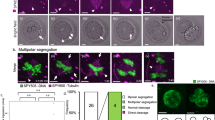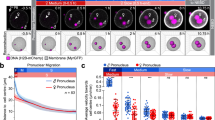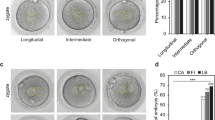Abstract
RABBIT eggs subjected in vivo to cold-shock treatment seldom abstrict the second polar body1, but frequently form one or two nuclei, resembling pro-nuclei, and may later undergo cleavage1,2. The response of the rat egg to cold-shock is different, in that the abstriction of the second polar body regularly occurs and the group of chromosomes remaining within the egg commonly becomes scattered1,3. Nucleus formation and cleavage have not been seen, but mostly the observations were restricted to a period of a few hours after the application of the stimulus.
This is a preview of subscription content, access via your institution
Access options
Subscribe to this journal
Receive 51 print issues and online access
$199.00 per year
only $3.90 per issue
Buy this article
- Purchase on SpringerLink
- Instant access to full article PDF
Prices may be subject to local taxes which are calculated during checkout
Similar content being viewed by others
References
Thibault, C., Ann. Sci. Nat. Zool., 11, 136 (1949).
Pincus, G., and Shapiro, H., Proc. Amer. Phil. Soc., 83, 631 (1940).
Austin, C. R., and Braden, A. W. H., Aust. J. Biol. Sci. (in the press).
Austin, C. R., J. Endocrin., 6, 104 (1949).
Austin, C. R., and Braden, A. W. H., Aust. J. Biol. Sci. (in the press).
Author information
Authors and Affiliations
Rights and permissions
About this article
Cite this article
AUSTIN, C., BRADEN, A. Nucleus Formation and Cleavage induced in Unfertilized Rat Eggs. Nature 173, 999–1000 (1954). https://doi.org/10.1038/173999a0
Issue date:
DOI: https://doi.org/10.1038/173999a0
This article is cited by
-
Experimental Parthenogenesis in the Mouse
Nature (1970)
-
Segmentation und Fragmentation der Eizellen in atretischen Eierstockfollikeln
Zeitschrift f�r Zellforschung und Mikroskopische Anatomie (1962)



